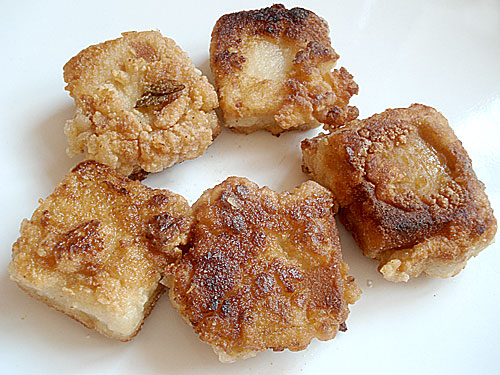
I was inspired to make these little nuggets of vegan goodness by a recipe for mochi chicken that was posted in the forums by member SojoMojo. He says that mochi chicken is a common dish in Hawaii; he grew up eating them and now loves to use them in his bentos. (As I learn more about Hawaiian cuisine, I realize that it departs from Japanese cuisine in many interesting ways, even if many of its roots are in Japan.) The mochi flour, cornstarch and egg batter produces a coating that is hard and crispy on the outside, and soft and mochi-like on the inside. Chicken lovers should try his recipe for sure!
For this vegan variation, I've used kouya dofu, or free-dried tofu. See an indepth description of kouya dofu. You can find it in the dried goods section of a Japanese grocery store, and it should be pretty inexpensive. It keeps indefinitely in the pantry, making it a great item to stock. If you can't get hold of kouya dofu, see the notes below about how to use regular tofu you've frozen yourself. I've also eliminated the egg from the coating, but the flavor-filled liquid in the pre-cooked tofu still produces a nice soft mochi-like interior.
As with all the vegan-protein recipes I post here, this tastes delicious to omnivores like myself too. As a matter of fact, when I packed a bento recently for the self-professed "bovo-vegetarian" in the house recently with these nuggets together with something meaty, he said he preferred these a lot more!